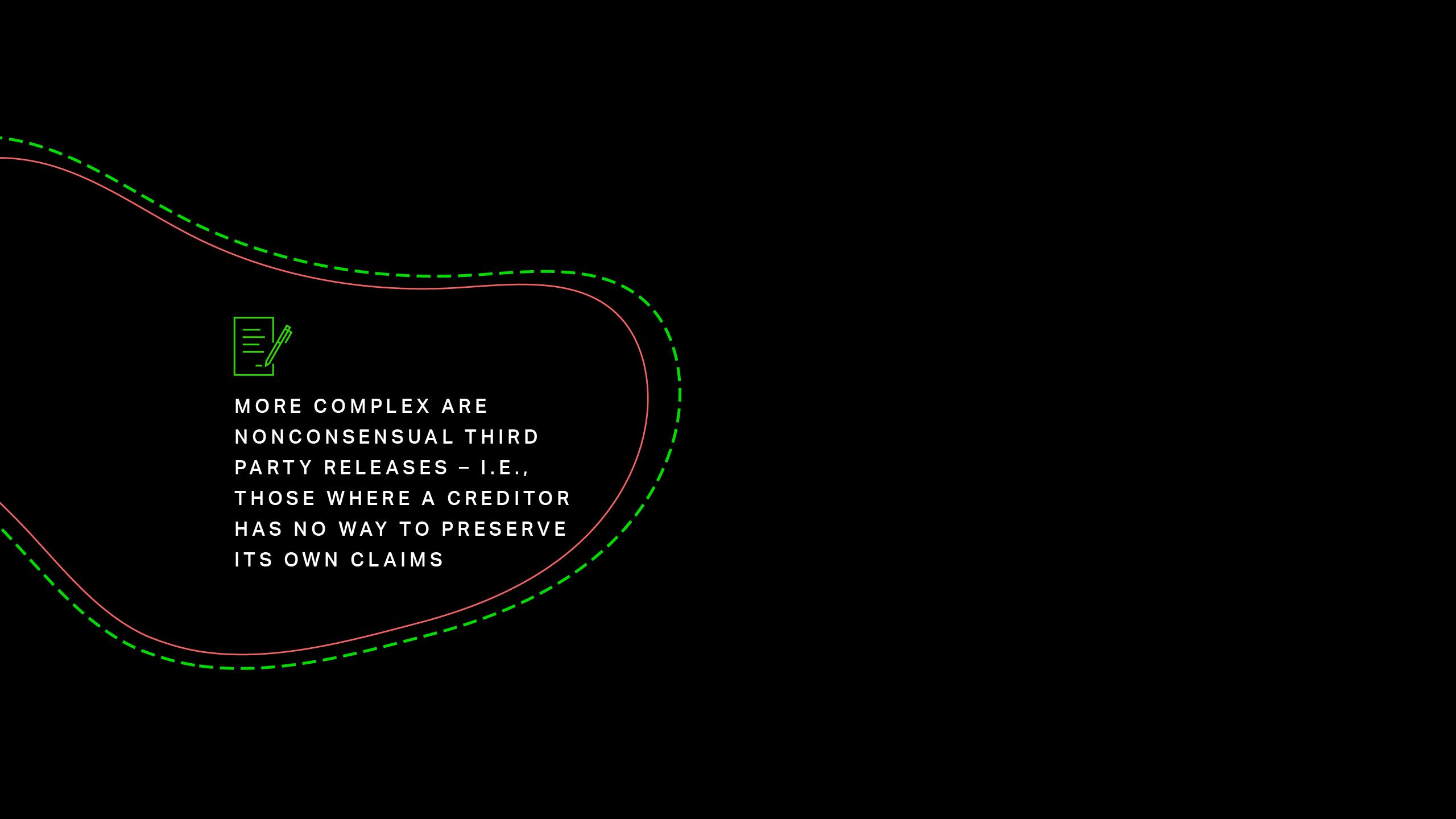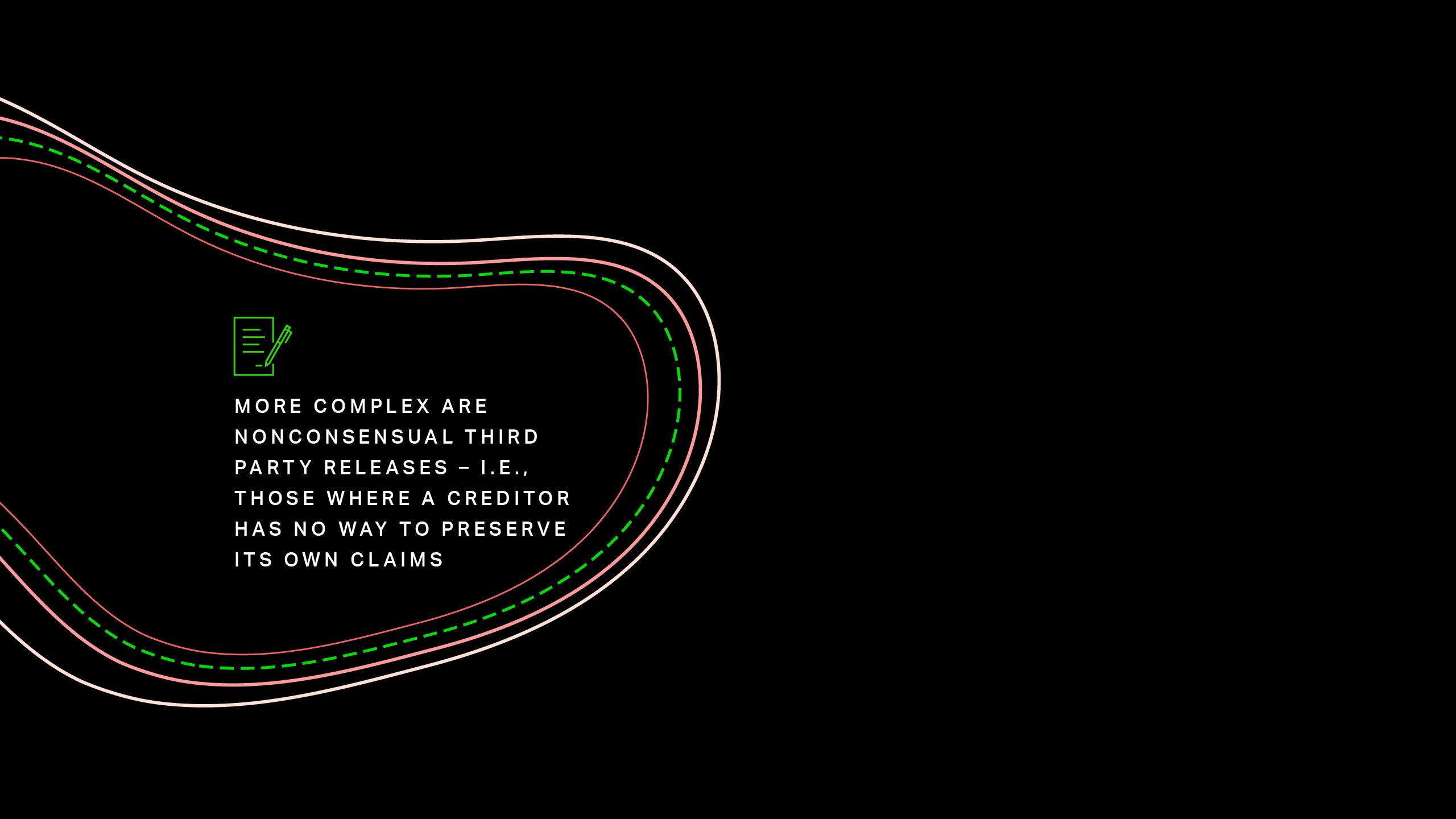
While the Supreme Court deliberates whether the Bankruptcy Code authorizes courts to approve third party releases1, the seven-factor test for considering such releases set out in In Re Purdue Pharma L.P. (“Purdue III”)2 remains a binding precedent in the Second Circuit3. Last month, a judge in the Southern District of New York weighed in on how those factors should be applied in a subchapter V small business bankruptcy4.

While the Supreme Court deliberates whether the Bankruptcy Code authorizes courts to approve third party releases1, the seven-factor test for considering such releases set out in In Re Purdue Pharma L.P. (“Purdue III”)2 remains a binding precedent in the Second Circuit3. Last month, a judge in the Southern District of New York weighed in on how those factors should be applied in a subchapter V small business bankruptcy4.


In In re Hal Luftig Co., the Bankruptcy Court recommended confirmation of a subchapter V small business reorganization plan that provided for the nonconsensual release of a non-debtor third party5. The Bankruptcy Court applied the Purdue III factors when considering the release6. It reasoned that the sixth factor – whether the impacted class voted overwhelmingly in favor of the plan – was to be given “little weight” in the subchapter V context7, where a plan can be confirmed without creditor consent. Last month, the District Court rejected these proposed findings8.
These decisions highlight the careful balance at play in subchapter V cases, where courts must provide adequate creditor protection while efficiently ushering small business debtors toward confirmation. Although subchapter V limits a creditor’s ability to prevent plan confirmation, the District Court in Hal Luftig Co. determined that these limits do not impact a court’s scrutiny of any third party releases contained within the plan.

Subchapter V Small Business Reorganization
The Small Business Reorganization Act of 2019 (the “Act”) enacted subchapter V of Chapter 11 to address the unique challenges small businesses face in their bankruptcy proceedings9. By expediting the reorganization process, the Act sought to reduce administration costs and remove barriers to confirmation10. In doing so, it removed some protections afforded to creditors under traditional Chapter 11 proceedings.
One notable difference under subchapter V is the application of “cram down” provisions – those allowing confirmation of a plan despite an impaired class’s opposition11. In a traditional Chapter 11 case, section 1129(b) permits confirmation of a plan that is not accepted by all impaired classes if it meets all other requirements of section 1129(a), including that at least one impaired class of creditors accepts the plan12. In a subchapter V case, section 1191(b) sets out the requirements for a nonconsensual “cramdown” confirmation13. Unlike its traditional Chapter 11 counterpart, section 1191(b) does not require an impaired consenting class of creditors14. Thus, a subchapter V plan that receives no creditor support can nonetheless be “crammed down” and confirmed.
Because subchapter V is a relatively new addition to the Bankruptcy Code, bankruptcy courts are more likely to face issues of first impression when applying its provisions. In doing so, courts are tasked with considering the special interests of a small business debtor and its creditors. In Hal Luftig Co., one such novel issue was the approval of third party releases in subchapter V plans.


Subchapter V Small Business Reorganization
The Small Business Reorganization Act of 2019 (the “Act”) enacted subchapter V of Chapter 11 to address the unique challenges small businesses face in their bankruptcy proceedings9. By expediting the reorganization process, the Act sought to reduce administration costs and remove barriers to confirmation10. In doing so, it removed some protections afforded to creditors under traditional Chapter 11 proceedings.
One notable difference under subchapter V is the application of “cram down” provisions – those allowing confirmation of a plan despite an impaired class’s opposition11. In a traditional Chapter 11 case, section 1129(b) permits confirmation of a plan that is not accepted by all impaired classes if it meets all other requirements of section 1129(a), including that at least one impaired class of creditors accepts the plan12. In a subchapter V case, section 1191(b) sets out the requirements for a nonconsensual “cramdown” confirmation13. Unlike its traditional Chapter 11 counterpart, section 1191(b) does not require an impaired consenting class of creditors14. Thus, a subchapter V plan that receives no creditor support can nonetheless be “crammed down” and confirmed.
Because subchapter V is a relatively new addition to the Bankruptcy Code, bankruptcy courts are more likely to face issues of first impression when applying its provisions. In doing so, courts are tasked with considering the special interests of a small business debtor and its creditors. In Hal Luftig Co., one such novel issue was the approval of third party releases in subchapter V plans.

Purdue and Nonconsensual Third Party Releases
Much has been written about the availability of so-called “third party releases,” or releases of claims held by non-debtors against other non-debtors. Bankruptcy courts have jurisdiction over such releases only when claims against the third party directly impact the debtor’s estate15. Third party releases are deemed consensual where claimants “opt in,” or in some jurisdictions where creditors are able to “opt out” of the release. More complex are nonconsensual third party releases – i.e., those where a creditor has no way to preserve its own claims. Such releases are closely scrutinized in some circuits and are categorically prohibited in the Fifth, Ninth, and Tenth Circuits16. In Harrington v. Purdue Pharma L.P., the Supreme Court has been asked to resolve the circuit split and to consider whether the Bankruptcy Code authorizes courts to approve Chapter 11 plans containing nonconsensual third party releases.
The case involves the bankruptcy plan for Purdue Pharma – the manufacturer of OxyContin17. The plan releases the Sackler family – the non-debtor owners of Purdue Pharma – from liability and does not permit creditors to opt out of the releases18.


Purdue and Nonconsensual Third Party Releases
Much has been written about the availability of so-called “third party releases,” or releases of claims held by non-debtors against other non-debtors. Bankruptcy courts have jurisdiction over such releases only when claims against the third party directly impact the debtor’s estate15. Third party releases are deemed consensual where claimants “opt in,” or in some jurisdictions where creditors are able to “opt out” of the release. More complex are nonconsensual third party releases – i.e., those where a creditor has no way to preserve its own claims. Such releases are closely scrutinized in some circuits and are categorically prohibited in the Fifth, Ninth, and Tenth Circuits16. In Harrington v. Purdue Pharma L.P., the Supreme Court has been asked to resolve the circuit split and to consider whether the Bankruptcy Code authorizes courts to approve Chapter 11 plans containing nonconsensual third party releases.
The case involves the bankruptcy plan for Purdue Pharma – the manufacturer of OxyContin17. The plan releases the Sackler family – the non-debtor owners of Purdue Pharma – from liability and does not permit creditors to opt out of the releases18.
The Bankruptcy Court approved the releases and appeals ensued. However, the District Court reversed the Bankruptcy Court decision, finding that nonconsensual releases were not authorized by the Bankruptcy Code. The Second Circuit subsequently reinstated the Bankruptcy Court’s decision, concluding that bankruptcy courts have equitable authority to approve the third party releases19. In doing so, it set out a seven-factor test for courts to apply when considering nonconsensual third party releases20. The Second Circuit concluded that the Bankruptcy Court’s “detailed findings” supported plan approval under each of the seven factors21.
The U.S. Supreme Court heard arguments on the case in December 2023, and a decision is expected to follow this year.


In re Hal Luftig Co.: Applying Purdue in a Subchapter V Bankruptcy
The potential impact of Purdue on subchapter V reorganizations was recently illustrated in In re Hal Luftig Co. There the debtor, a theatrical production corporation, filed for small business reorganization under subchapter V22. A significant portion of the debtor’s debt was an arbitration judgment that FCP, an investor in the debtor, had obtained against the debtor and its president and sole shareholder, Hal Luftig23. The debtor’s plan contained a provision releasing both the debtor and non-debtor Luftig from all claims against them held by FCP24. FCP and the U.S. Trustee objected25.
The Bankruptcy Court, applying the Second Circuit’s Purdue factors, concluded that each factor favored approval of the release except for the third – the scope of the releases – and the sixth – “whether the impacted class voted overwhelmingly in favor of the plan”26.
With respect to the third factor, the Bankruptcy Court determined that modifying the plan to require that the debtor’s conduct be a legal cause of or a legally relevant factor to the released claim would resolve this factor in favor of approval27. As for the sixth factor, the Bankruptcy Court acknowledged that it was not met where the sole impacted class, FCP, was “unequivocally opposed” to plan confirmation28. Nonetheless, the Bankruptcy Court reasoned that this factor “has little weight” in the subchapter V context where creditor consent is not a statutory requirement of plan confirmation29. Consequently, the Bankruptcy Court recommended confirmation of the plan30.


In re Hal Luftig Co.: Applying Purdue in a Subchapter V Bankruptcy
The potential impact of Purdue on subchapter V reorganizations was recently illustrated in In re Hal Luftig Co. There the debtor, a theatrical production corporation, filed for small business reorganization under subchapter V22. A significant portion of the debtor’s debt was an arbitration judgment that FCP, an investor in the debtor, had obtained against the debtor and its president and sole shareholder, Hal Luftig23. The debtor’s plan contained a provision releasing both the debtor and non-debtor Luftig from all claims against them held by FCP24. FCP and the U.S. Trustee objected25.
The Bankruptcy Court, applying the Second Circuit’s Purdue factors, concluded that each factor favored approval of the release except for the third – the scope of the releases – and the sixth – “whether the impacted class voted overwhelmingly in favor of the plan”26.
With respect to the third factor, the Bankruptcy Court determined that modifying the plan to require that the debtor’s conduct be a legal cause of or a legally relevant factor to the released claim would resolve this factor in favor of approval27. As for the sixth factor, the Bankruptcy Court acknowledged that it was not met where the sole impacted class, FCP, was “unequivocally opposed” to plan confirmation28. Nonetheless, the Bankruptcy Court reasoned that this factor “has little weight” in the subchapter V context where creditor consent is not a statutory requirement of plan confirmation29. Consequently, the Bankruptcy Court recommended confirmation of the plan30.
In a March 2024 decision, the District Court rejected the Bankruptcy Court’s reasoning with regard to Purdue’s sixth factor, declaring that the Bankruptcy Court’s reliance on subchapter V’s confirmation requirements was “inapposite”31. The Court explained that these sections of subchapter V “do not address the authority of a court to release the debt of a third party”32. Recognizing the “tangible financial harm” the non-debtor release would cause FCP and the lack of “safeguards of the Bankruptcy Code,” the District Court denied confirmation of the plan33.

Final Verdict
Subchapter V was intended to streamline reorganization and remove barriers to plan confirmation for small business debtors. To achieve this, subchapter V removes some protections for creditors, including certain requirements under the cramdown provision. In Hal Luftig Co., the Bankruptcy Court and District Court considered these vying interests in the context of third party releases. The District Court determined that subchapter V’s cramdown provisions should not impact creditors’ rights or reduce their protections with regard to nonconsensual, third party releases.
To the extent Hal Luftig Co. I suggested subchapter V offered a loophole by relaxing one of Purdue III’s factors for third party releases, Hal Luftig Co. II closed that loophole. Thus, with respect to nonconsensual third party releases, the Hal Luftig Co. District Court drew a line in the sand in favor of creditor protections over subchapter V’s goal of streamlining reorganization for small business debtors.

Final Verdict
Subchapter V was intended to streamline reorganization and remove barriers to plan confirmation for small business debtors. To achieve this, subchapter V removes some protections for creditors, including certain requirements under the cramdown provision. In Hal Luftig Co., the Bankruptcy Court and District Court considered these vying interests in the context of third party releases. The District Court determined that subchapter V’s cramdown provisions should not impact creditors’ rights or reduce their protections with regard to nonconsensual, third party releases.
To the extent Hal Luftig Co. I suggested subchapter V offered a loophole by relaxing one of Purdue III’s factors for third party releases, Hal Luftig Co. II closed that loophole. Thus, with respect to nonconsensual third party releases, the Hal Luftig Co. District Court drew a line in the sand in favor of creditor protections over subchapter V’s goal of streamlining reorganization for small business debtors.






